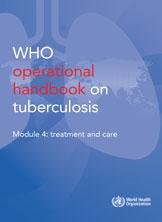Module 4: treatment and care

 TB KaSPar
TB KaSPar
 Feedback
Feedback
Refer to Annex 10: Summaries of unpublished data and analysis plans used for the recommendations in the WHO treatment guidelines for multidrug- and rifampicin-resistant tuberculosis, 2018 update.
https://iris.who.int/bitstream/handle/10665/311390/WHO-CDS-TB-2019.3-eng.pdf
Funding for the meetings and reviews involved in the updating of the guidelines came entirely from the United States Agency for International Development (USAID). The experts on the Guideline Development Group (GDG) and the institutions where they work contributed time for the various discussions and other activities involved in the update process.
All members of the group completed a Declaration for the Conflict of Interest; there were no conflicts declared.
The following members declared no interests: Si Thu Aung; Frank Bonsu; Jeremiah Chakaya; Lucy Chesire; Daniela Cirillo; Poonam Dhavan; Kathy Fiekert; Andrei Mariandyshev; Nguyen Viet Nhung; Ejaz Qadeer; Abdul Hamid Salim; Holger Schünemann; Pedro Suarez; Justin Wong Yun Yaw.
Drug-susceptible TB treatment
Participants in the Guideline Development group meeting on Drug-susceptible TB in 2009
Guideline Development Group
Solange Cavalcante, TB Control Program Coordinator, Rio de Janeiro municipality, Rio de Janeiro, RJ, Brazil
Jeremiah Muhwa Chakaya (Chairperson), Technical Expert, National Leprosy and TB Programme, Kenya Medical Research Institute, Nairobi, Kenya